“Armenian grief is a sea…
In that dark expanse drifts my soul…
In the sea of Armenian sorrows—
My soul languishes evermore.”
Hovhaness Tumanyan, 1903
Armenian poet and writer (1869-1923)
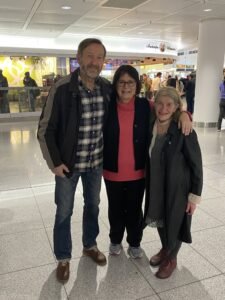
At last, our flight from Chicago to Germany had reached its destination. My daughter Hasmik and I had arrived in Munich, known as the “cosmopolitan city with heart,” and home to the Rathaus-Glockenspiel, a huge, ornate clock that “chimes and re-enacts two stories from the 16th century…” Munich, which was heavily bombed during World War II, is also known for its Oktoberfest and beer. As we quickly walked through the jet bridge, Hasmik whispered, “Mom, I can’t wait to meet Anusch!” As she said those words, I grew even more excited to at last see Anusch, my DP (Displaced Persons) camp childhood playmate, again. At the terminal gate, a large group of people were waiting for either family, friends or acquaintances. Among them were Anusch and her husband Johannes, Hansi or Hans for short. We hugged each other tightly, again and again. After our greetings and hugs, Anusch being my “senior” by a couple of months, grabbed my hand and squeezed it firmly, as if to say, “We will never lose each other again!” Having collected our luggage, we walked out of the airport with Hans and Anusch pulling our suitcases behind them (they would not allow us to do it) and down the stairs to catch the train to our hotel, only a 20-minute ride away. And from there, it was another 20-minute bus ride to the Bavarian town of Ludwigsfeld at Dachau, located “on the grounds of the largest former Outer-Camp of the Dachau Concentration Camp, then called KZ-Ausenlager (Outer Camp), Allach 1. The outer or subcamps were the outlying detention centers that came under the command of a main concentration camp run by the SS in Nazi Germany and German occupied Europe.”
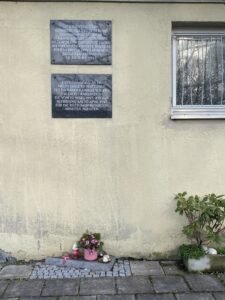
As we stepped down from the bus, Anusch explained, “The grounds in this wooded area are where countless displaced persons after World War II had been interned.” As we continued walking and chatting, Anusch and Hans announced as one, “Come, our home is just over there!” As we got closer to their apartment building, I noticed sneakers, in a variety of sizes, hanging like ornaments from the limbs of a nearby tree. We all chuckled. No doubt the amusing sight had been playful pranks by some of the kids in the area. As we stopped for a moment to gaze about and at the dangling shoes, Anusch further explained, “After the war, this settlement or estate as it is also called, was built in 1952 as a Displaced Persons camp by the American Marshall Plan, ‘an initiative for foreign aid to Western Europe following World War II.’”
“This area,” Anusch continued as she pointed here and there, “consists of 32 blocks of apartments on the outer grounds of the Dachau Concentration Camp. My parents moved into our 50-square-meter, three-room apartment, with separate toilet, on 3 January 1953. We felt blessed! Our youngest brother still lives in the apartment where he was born sixty-five years ago. They named the streets here with names such as diamond, ruby, crystal, etc., in order to cover up the grim past. The estate is situated in an isolated area on the outskirts of Munich. One of the reasons for this is because when the DPs were brought to this location, ninety-percent of them were ill. About seventy-percent had tuberculosis, ten-percent suffered from psychological illnesses and venereal disease, and another ten-percent had other problems.” Anusch added, “The ‘Siedlung Ludwigsfeld,’ as it is now called, is a very special place. To this day, former DPs come to visit from all over the world. Also, American relatives of the former slave-workers of the Outer Concentration Camp come regularly on the day of Liberation on 30 April (1945). Recently, our American friend Nick, a 99-year-old survivor from California, came here with his family, and we all had breakfast at our home.”
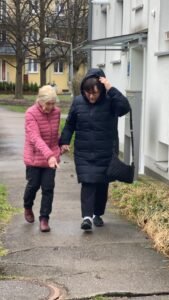
From the moment we greeted one another and held hands at the airport, and for the entire week we were there, the two of us, wherever we went, were inseparable—tightly holding hands as we walked about. There were moments that I felt as if we were back at the Waidmannsdorf Lager C, DP Camp, Armenian Section, in Klagenfurt, Austria, exploring our world in our little high-top shoes, hand-made dresses, at times wearing an apron over our dresses to keep them clean. Our world back then was of destruction, homelessness and hopelessness; cruelty, fear and despair; separation and loss; hunger, illness, disease and death—the ugly aftermaths of war. But, in that same world, oftentimes there was also something wonderous to discover—a worm, an insect, a bird, a butterfly, an ant hill, a patch of wild flowers, even an occasional cat or dog. Most importantly, though, wherever our little feet carried us on the campgrounds, we found an abundance of affection in the form of smiles, hugs and kisses from the adults, both male and female, in our camp, whom we addressed in German as either “Onkel” or “Tante” (Uncle or Auntie), as they would reach for us—two little two-year-old toddlers curiously and carefreely roaming about. Joyfully, tenderly, Onkel or Tante would lift us into their arms and carry us, like precious little gems, back to our makeshift shacks. For Anusch, there was an additional discovery she had made during one of our great outdoor adventures, and something she greatly prized—my mother’s metal pail. Whenever it disappeared, my mother Olga knew exactly where to look for it. Grinning as she would step out of our shack, my mother would call out in her Austrian-German, sweet and lilting voice, “Where is my pail?” There, a short distance away, she would find little Anusch busily stirring mud porridge in the pail.

In one of the photos that Anusch showed me, there were the two of us with one of the Armenian DPs in the camp, whose name was Zorik, and a cat and dog. It was a photo I had never seen before, and it reminded me of Hovhaness Tumanyan’s poem titled “The Dog and the Cat.” My father would often read that poem to me in Armenian, one of my favorites growing up. I asked Anusch who the photographer was and she said, “My father loved photography and sometimes he would take the pictures, sometimes it would be someone else. They would develop the photos themselves.”
The people, such as the Hayastantsi (from Armenia) men in the camp, had experienced and survived hell in their Soviet “Haven of Brotherhood.” Some had also lost their families and had no one, while others never had a chance to start a family. Zorik was one of those DPs who had no family. That is why for those men every child in the camp was precious, and it brought them joy to be a part of their lives. For that reason, we little ones of the camp had many eyes dotingly watching over us. My father, Suren Hakopjani Hovhanessian, would not only tell me, but had written about life “Under Stalin’s ‘Happy’ Sun.” One day, as he and I talked about those bleak days in Europe, he pensively described his innermost feelings, which he rarely did—in particular, how he felt nearly every waking moment as a POW. “Words,” he said, “cannot adequately express the constant terror and anticipation of forced repatriation to the Soviet Union at any moment…and there, immediately shot to death.” This horrific thought was what he and his fellow Armenian POWs, some of whom, among them my father, were also slave laborers, constantly lived with. Unfortunately, the men that trustingly did “repatriate,” against the pleading, the imploring of their fellow POWs, were promptly shot to death as traitors to Stalin’s “Haven of Brotherhood.” When I had asked my father about camp life, he said, “Life in the camps, though the conditions were dreadful, unimaginable, it was still better than life under Stalin and in his prisons. In the camps there was at least a glimmer of hope, while over there, in Stalin’s ‘Happy Life Country,’ not so.”
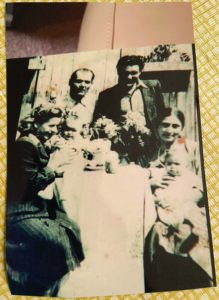
In a published photo Anusch showed me, the description stated that the POWs, who were also slave laborers, were fenced in a muddy and dirty area in certain places and given the scarcest of food. For their amusement, the commanders would, at times, toss stale and moldy bread at the POWs. Those who were quick enough to grab the bread devoured it as others, with arms pleadingly extended, watched on. In a 1945 photo, the bones of slave laborers had been piled in a high mound to either be burned or buried. And, in an artist’s drawing, the depiction of British soldiers brutalizing and callously forcing the POWs to return to the Soviet Union was heartrending to look at. Some escaped the clutches of the soldiers, while others were driven to their deaths. “After the war,” Anusch then explained, “everyone—the people and the DPs alike—was starving.”
Though Anusch’s birthday was just a couple of months before mine, she was much smaller that I was due to severe malnutrition and poor health. As a result, her growth was stunted and as an adult, she is an extremely petite woman. During the time we lived in the Austrian DP camp, she remained with her parents, while I was often sent away to live with kind strangers who cared for me as their own. In France, and then in the German DP camp called Funkerkaserne, near Stuttgart, Germany, I was again put into the care of kind strangers for a period. The reasons for such arrangements during those days were either because both parents had to work or they would not receive food rations (Hitler’s orders), or one or both parents had tuberculosis. My father had contracted tuberculosis when he and fellow POWs were first brought to Europe and was treated. Later, when my parents married, my mother contracted typhoid. The people in the camp suffered greatly from malnutrition and disease. Everyone, no matter their age, was sprayed from time to time with DDT. Food was so scarce that sometimes children would eat grass to fool their empty little bellies. Anusch, at times, would tell her father, “I am not hungry, so I will go out and play,” and then promptly search for grass to eat. Since my father was a POW and slave laborer, and my mother was a nurse in the nearby hospital, they both had to work and therefore were unable to care or provide for me. There were a great many such cases after World War 2. In Anusch’s case, she and her brothers Arshak and Georg were eventually sent to live elsewhere for periods of time in order to receive proper nutrition and regain their health, to a degree. As a grown woman and mother of five, grandmother of ten, and great-grandmother of four, the soft-spoken and petite Anusch is a natural storyteller with a remarkable memory for details.
As we would sit at her dining room table during our time together, Anusch would tell me of her childhood in Austria, and later in Germany. Her eyes would grow misty as she would speak of her parents, especially her father and some of the other Armenian DPs, along with their non-Armenian wives, who would sometimes stop by their home for a visit. She would describe how after chatting with one another, sparks of nostalgia and longing would spur the men to their feet to sing and dance, just as they had done a lifetime ago in their homes in their beloved Hairenik (Fatherland). The wives would join in the fun by clapping and singing the Armenian songs the best they could, while one of the men would beat on a metal pot, keeping perfect rhythm to the claps and voices that blended as one and reverberated throughout their living quarters. As I listened to Anusch recollect those early days, I thought, though they all had little, suffered greatly, and lost so much, they had each other and that was enough.
On our first day at Anusch’s home, we sat down to a dinner of dolma, just the way my mother had learned to make it from my father, with delicately spiced meat carefully wrapped in cabbage leaves and cooked in tomato broth. Though Anusch said that she did not think her cooking was good, Hasmik, Hans and I disagreed. It was delicious, and it reminded me of home when I was a child and the times I spent in
Armenia! Anusch and I would spend hours discussing the topic of the Armenian DPs at the camp and after, while Hans would occasionally play Armenian folk music or the music of Gomidas on the record player, while he either read in the living room or sat with us at the dining room table. “From the moment I heard Armenian music in Anusch’s father’s home many, many years ago,” Hans said as he put down his newspaper, “it captured my heart!” and then affectionately glanced at Anusch. (It is the same kind of music that played in my parents’ home when I was growing up, and then in the home my late husband Murad and I had made together.) Though Hans is German, he has learned a little Armenian, knows the history well, and is involved, along with Anusch, in various Armenian activities. Armenian folk music, Han’s favorite, is often played in their home. And once, when we were preparing to visit some of their children and their families in the neighborhood, he smiled as he called out to hurry his wife in the other room, “Haydeh, Anusch!” Truly, the spirit of an Armenian home created under the most difficult circumstances by Anusch’s father, and mother, is continued by his children and grandchildren.
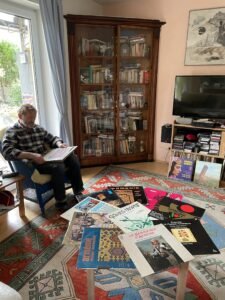
Anusch’s dining room, which overlooks part of the Dachau Outer Camp with its many dreadful stories, and later, the heartbreaking stories about some of the DPs that made their home in the settlement, I was again reminded of our early days in the DP camps my parents and I called home for awhile, and then our early immigrant days in Chicago. Some of the DPs in Chicago would occasionally gather in our small duplex on Saturday evenings to catch up on the latest news from Armenia and play chess or backgammon, while the women congregated in the kitchen over cups of coffee and my mother’s Viennese apple strudel. Over the years, as I listened to my father’s stories, and that of other Armenian DPs, I both admired and was amazed by them for their courage and determination to carry on, despite the horrors and severe deprivations they had suffered and the difficulties that followed for years afterward. And of my mother, and the other non-Armenian wives of the Armenian DPs, I have always had a special place in my heart for them because of the things they too suffered, both growing up in their homelands and during and after the terrible war years, and later the hardships they had to overcome in a new country. I particularly admired and appreciated how my mother, and some of the other wives, had encouraged their children to follow the traditions of their Armenian fathers.
In Anusch and Hans’ family, their daughter Rebeka is taking Armenian language courses, and granddaughter Hannah Araxie, who attends Catholic University (Faculty of History and Social Sciences) in Germany, has written a research paper titled “Diaspora Armenian’s Collective Memory of the Distant Homeland: Genocide, Diaspora and the Theory of Collective Memory.” One of Anusch and Hans’ sons, Sevan, whose wife is German, has a nine-year-old daughter named Nora. Every evening, before bedtime, Nora asks her mother to read yet another story (in German) by Hovhaness Tumanyan.
Over another cup of tea and Armenian pastry prepared by Nina, Anusch’s friend and neighbor, who was from Armenia (when Nina and her family moved to Germany several years ago, they learned of Anusch’s special neighborhood, and soon after, Nina, her husband and two children moved to the settlement), Anusch began to talk about her father. “My father, Malchas Krmadjian, was born in Javakhk, Georgia, but his forefathers had been from Garin (Erzerum). Malchas was married at 18, and his bride was 14. They had 10 children. One day, as he was working in his field, he was snatched by soldiers and forced to serve in the Soviet Russian Army, where he was assigned to the Cavalry. In 1941, he was captured by the Germans and given an ultimatum: ‘Join the German Cavalry or be sent to a concentration camp!’ He chose the former. He had served first in the Russian Cavalry for five years and later in the German Cavalry for four years. As a result of his years in the Cavalry, he sustained severe wounds that plagued him throughout his life. Always missing his family in Javakhk, and haunted by the things he saw and experienced during the war and after, he eventually grew extremely depressed. Encouraged to begin a new life in Germany by his Armenian DP friends, since the country was now their home, slowly he did just that, but always there was a longing for the home and family he was forced to leave behind and the realization that he would never see them again. Upon meeting a young German girl, Margarete, who would become his wife, for there were no Armenian girls in Austria or Germany at that time, he started a new family and learned a new language – German – though haltingly, besides the Armenian and Turkish that he knew.” Anusch somberly looked away for a second and then continued, “Before my father’s death of a heart attack, he said to us, ‘Listen my children, I have lived for 60 years, but it feels like 120.’ We all cried and repeated over and over, ‘Papa, don’t die, don’t die!’”
A part of Malchas’s story reminded me of a Hayastantsi who had lost his leg in the war and lived with us in Chicago for a while in our small, three-bedroom duplex that had one bathroom, a living room, dining room and kitchen. Though we were cramped, my parents felt it was their duty to help fellow Hayastantsis, who had even less than we had. And so, my parents, four siblings and I slept in one bedroom; the Armenian who had lost his leg slept in the other; and later, a poverty-stricken family from Armenia – a father, mother and child – who came to live with us, slept in the third bedroom. Though we lived in cramped quarters and had little, we never felt poor because of our parents, who themselves grew up in great hardship. My father, who was from the village of Shvanidzor in Syunik, and located in Armenia’s southern region, was a toddler when his father passed away from pneumonia, and by age nine, his young mother, who, carrying a bucket of water up the hill to their house dropped dead when she heard the frantic and dreaded words, “The Turks are coming! The Turks are coming!” Having to survive on his own since childhood, he knew the value of family, as did my mother. Remarkably, despite their harsh lives, my parents always remained generous, kind, optimistic and thankful. Since we, as a family, were all together, despite our circumstances, we were happy and felt fortunate to live in a country that offered such great freedom.
One evening, the somber and quiet Armenian who had lost his leg told my father that he was going to end his life. My father immediately told my mother that he was going out for a walk with the man. Both returned late that night. Somehow, my father had convinced the dejected Armenian that he could not do what he was planning to do, that in time life would improve for him. When he eventually moved out of our home, his life had indeed taken a sunnier path, and the family of three had at last also found a better life in their adopted country of America.

As Anusch and I talked and talked, stopping occasionally to look at the photos she had, and the ones I had on my phone, I realized how similar the two of us were in several ways, especially when it came to our love for all things Armenian. Perhaps that is why we bonded as toddlers, and now as adults. Having nearly finished with my interview, I asked Anusch what some of the nationalities in Ludwigsfeld were. She replied, “Armenian, Azeri, Belarus, Bosnian, Bulgarian, Chechen, Croatian, Georgian, Greek, Hungarian, Romanian, Russian, Serbian, Slovenian, Tatar, Turkmen, Ukrainian, Uzbek.” And of the religions, she said, “We have Christians, among them Armenian Apostolic, Greek Orthodox, Russian Orthodox, Roman Catholic, Evangelical, Lutheran, Jehovah’s Witnesses, and we have believers in the Jewish and the Muslim faiths.”
As I listened to Anusch describe her neighborhood, my old neighborhood in Chicago where we first settled came to mind. It was a neighborhood of local Americans and immigrants surrounded by factories and dotted with a few apartment buildings, and single homes, two flats and duplexes. Our international neighborhood then consisted of three Armenian families – two Hayastantsi and one from Turkey – several local American families, some of them elderly, a few Appalachian families, a Georgian family from the Caucasus, several German families, a few Italian families, a couple of Mexican families, a Polish family and a Russian family. Many of the men in the neighborhood, as well as a few of the women, worked in factories near and far. My father was more than happy to have his factory job, as did other Armenian immigrants, even though he had been a writer and teacher in Armenia.
When my family and I moved to another part of Chicago during my teen years, and later, when we five siblings married, all but my late husband Murad and I, and our family, remained in the area that had become home since my family and I arrived in America many years ago. On the other hand, Anusch and Hans, and their children, now all married with families of their own, still live in the same neighborhood where Anusch’s parents first made their home, except for one daughter who lives not too far from her parents and family. A sense of unity and belonging that was a part of their lives growing up continues today, whereas our lives in the Chicagoland area have greatly changed over the years because of distance and relocations.
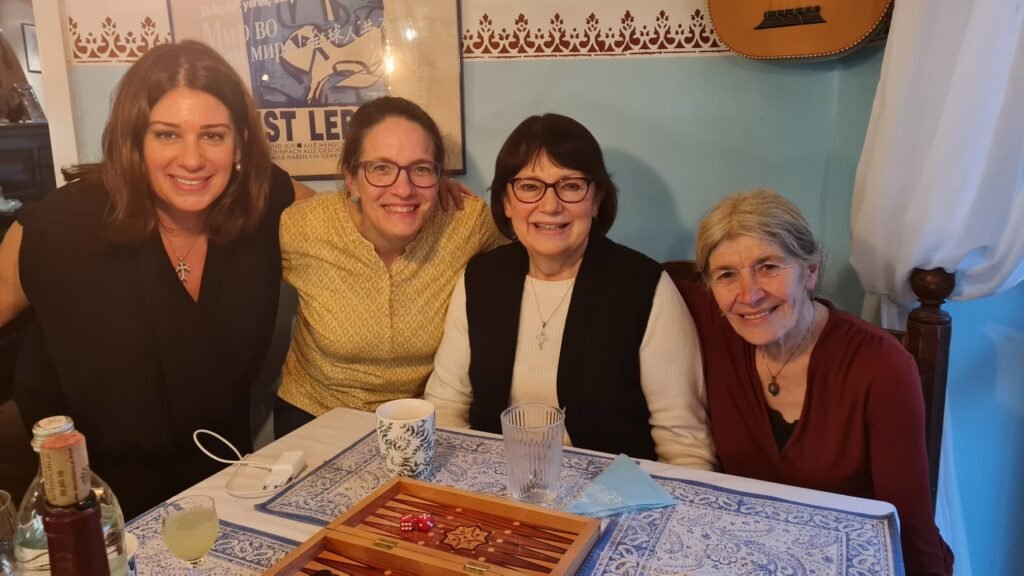
As Anusch and I continued our conversation on the DPs and their lives in Ludwigsfeld, it was apparent that Anusch’s life, and that of her family, was tightly woven with the lives of the other Armenian DPs who lived in the area. Over the years, however, many of them moved away to other cities in Germany or to other countries, leaving behind a neighborhood that had once been an example of “man’s Inhumanity to man” and hopelessness, but was eventually transformed into a place of hope with quiet, tree-lined streets, well-maintained buildings and grounds, and where children and youth play in open fields and adults gather regularly to spend time with one another or stroll about. When I asked Anusch if she considered herself to be German or Armenian, she replied with a smile, “I, the eldest of my father’s second marriage, consider myself an Armenian with a German mother, a German husband and a German passport!” Anusch then added, “After much searching, we found members of my father’s first marriage and now keep in touch with them. Though our Armenian is very limited, we are able to pass on our Armenian side as much as we can.”
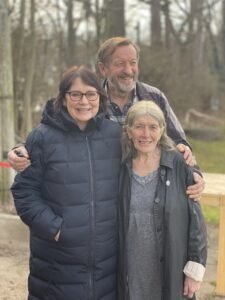
Wanting to know a little of what Anusch and Hans’ adult children thought about the place they call home, Sarah, who moved away from Ludwigsfeld, described how she felt about life in the area that her parents, siblings and their families call home: “I live in a charming old town near the Danube, with my family, and commute to my workplace in Munich, near my childhood home. I frequently see my parents and the rest of the family. It makes me happy there. Although I felt embarrassed in the past to show others where I lived because the blocks of buildings looked a lot uglier in the past, and the area did not have the best reputation, meaning that it was referred to as the ‘foreigner’s place,’ and was viewed with contempt by a still-hostile neighborhood after World War II. I appreciate the close community we grew up in – all the different nationalities, but feeling close as brothers and sisters…As an adult, I have always been proud of the special place I came from…I see it as a treasure that I had a chance to grow up there with so much community life.” To add to community life, in particular the Armenian community, once a month the Armenians rent a church, St. Anne, in the middle of Munich, and an Armenian priest from another area comes to perform church service. Occasionally, the Armenians also gather to socialize with one another, a tradition they have kept since the early days in the settlement.
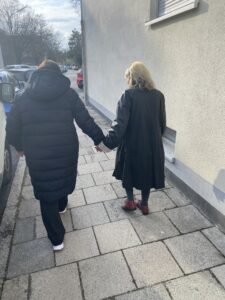
My time with Anusch, and her lovely family, had ended. In the morning, Hasmik and I would be returning home. Though it was an evening touched with sadness because our time with one another had ended, the visit had given us a deeper insight into the history of that dark period in the lives of so many. Thankfully, there are pictures and accounts that say much about those days. In addition, the lives of two toddlers in an Austrian DP camp were captured in a few of the photos, along with the faces of some of the DPs. Without those photos, their stories may have been forgotten long ago.
A few weeks after our return home, Anusch had written to me with additional information about her father and DP life. She ended her note with these words: “Well, dear Knarik, this is the story of only two displaced persons – our fathers. The reprisals that we, the descendants, had to go through, I will tell you another time…”
“…O falling star
Seen once from a bridge—:
Never to forget you. Stay standing! …”
Rainer Maria Rilke, 1915
Austrian poet and writer (1875-1926)


Knarik, 73 years ago, you and Anusch may have been considered ‘star-crossed playmates’, but as fate would have it, you were blessed to beat the odds, and be reunited in 2023!
Your story is extraordinary in so many different ways. The simplicity, honesty, and directness, in which you tell it, in both words, and photos, is informative, insightful, and inspiring. You remind us that despite the horrific challenges faced by the Armenian DPs, the majority of them moved forward with their lives, and with determination, commitment, hard work, and personal sacrifice, were able to honor and preserve their Armenian identity, a tribute to their Armenian spirit! Thank you for your powerful story!
Dear Mrs. Barsamian, Would you happen to be a former teacher at James Monroe Elementary in Chicago? If so, I’d like to thank you. I often think of my teachers with gratitude, and (if you are in fact the Mrs. Barsamian I remember so fondly) you stand head and shoulders above the rest. I’d like to express how your teaching helped open up the world to a young me. Thank you very much.
Phyllis Cohen
(You’re welcome to contact me if you wish. My email is my full name at gmail)
Wonderful article and a dream came true. Life is short and enjoy it with family and friends.
Thank you for sharing, keep writing!
Thank you, Knarik, for preserving a slice of history that many know so little about. Your story was sensitively told and very moving and now it is part of our collective history. Gratitude.